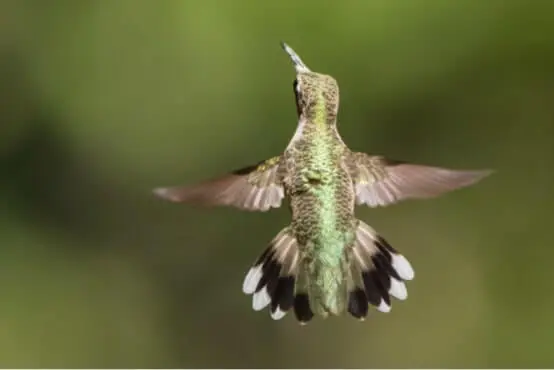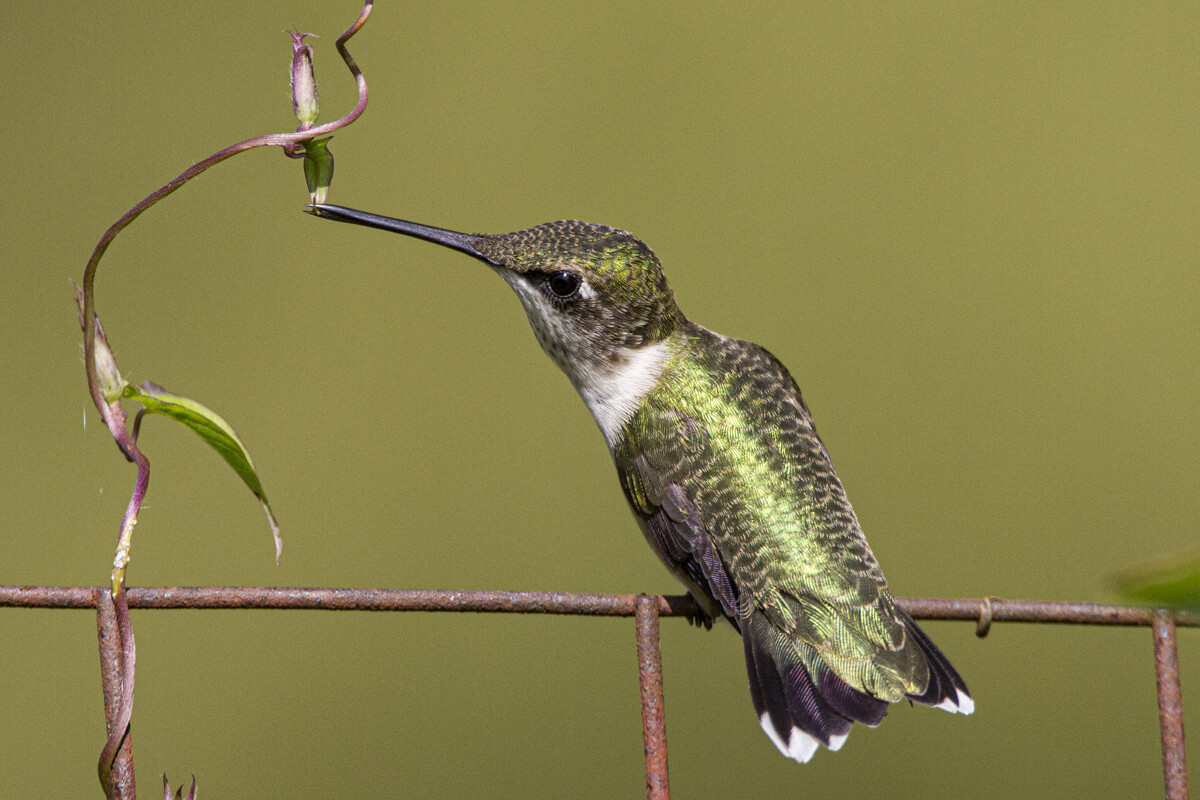Ruby-throated Hummingbird – February

Ruby-throated Hummingbird, back view with tail spread. Photo by Mike Dunn.
By Gerry Luginbuhl
Author: John A. Gerwin
February is a chilly, darker month. In the Piedmont of North Carolina, we experience some of the coldest nights, and least amount of daylight. The Ruby-throat is a Neotropical migrant, similar to the warblers, vireos, thrushes, tanagers and more that breed in NC. Most of “our” hummingbirds departed months ago. In NC, some leave as early as late July, others follow as summer turns to fall, and most are gone by late October. They make their way to Mexico or countries in Central America.
Most Ruby-throats migrate south. However, not all of them do. For years, folks have reported wintering hummers in NC. And for some of those years, Susan Campbell and colleagues have caught, measured, photographed, tagged, and released many. They have found a mix of species, but many were Ruby-throats. We do not know why this happens (but we have some opinions all the same. We’ll see if we can get Susan to chime in one month).
During the winter months in Mexico/Central America, a Ruby-throat will be in places with a handful of other species. Keepers of bird lists currently list 340+ species of hummingbirds – all in the western hemisphere. “Neotropics” means New World Tropics. I’ve seen a few Ruby-throats on the west side of Nicaragua for example. Where the Ruby-throat can be found in Nicaragua, one might also find two dozen other species of hummingbirds. I have included pictures of a few of these other species.
In the non-breeding season, the Ruby-throat prefers habitat in areas that are drier overall, and often a bit scrubby (forest openings with second growth, forest edges, and some agricultural settings; among others). They will nectar at flowers we might grow in our gardens – various Salvia species for example. They continue to feed on minute arthropods for protein, and have an inordinate fondness for small spiders.
We know that hummingbirds exhibit some extreme life history behaviors and physiological adaptations. One of these concerns the molt cycle and there are aspects of the molt cycle we do not yet fully understand. Hummingbirds, as a group, rely on flight for feeding. Due to their small size, they are subject to extreme “stress” in order to maintain their high body temperature and functions. All to say, they do not molt quite like other birds. I can’t get into all the details here but will note that adults undergo a complete molt (body and flight feathers) after the breeding season. What’s really curious is that recent research has shown that some individuals undergo a molt in summer and apparently another during the winter.
In songbirds the post-breeding season molt can be completed in 6-8 weeks. In Ruby-throats, it is reported to be slower and much more protracted, when compared to the migrant warbler or thrush.. An interesting aside: in 1936 a researcher counted the number of body feathers on some Ruby-throats; he came up with 940.
At the species level then (Ruby-throat), the molt cycle runs from late summer to mid-winter. Individuals will do things differently, and as mentioned some may begin to molt body feathers in late July. These Ruby-throats then migrate while they are molting (or, if you prefer, molt while they are migrating). The question is, when does that July-molting bird complete the molt? No one knows for sure. One researcher did a fairly thorough study of the molt of Ruby-throats, assessing individuals in Mexico and Central America. His data showed that many Ruby-throats began a molt of the flight (wing/tail) feathers in November and completed it by the end of February. Many (most?) individual Ruby-throats complete the body molt in March, when the males’ new gorget feathers grow in. Still, other aspects of the molt remain unknown. To understand precisely which birds are molting what/when/where, we will need a lot of marked birds that can be followed, month to month.
In February, Ruby-throats are sharing time/space with a large variety of tropical hummingbird species. In addition, they are preparing for the northward migration and some will indeed begin to migrate north during February. Many aspects of their migration also remain unknown – but we do know that some will arrive in the southern U.S. by early March.
Here we provide a link to Cornell’s eBird website for the non-breeding range of the Ruby-throated Hummingbird. This is a page where the user can zoom in and do other ‘animations’ (note also options on the right-hand side).
https://science.ebird.org/en/status-and-trends/species/rthhum/range-map?season=nonbreeding
Finally, I have included photos a few species of tropical hummingbirds in Nicaragua, which ranges overlap that of a given non-breeding Ruby-throated Hummingbird.







